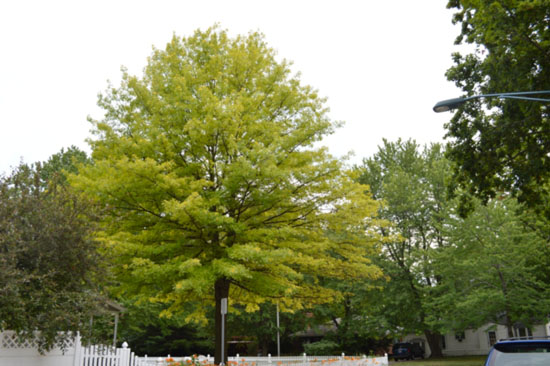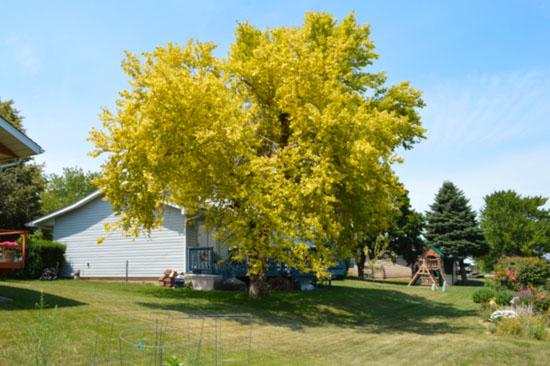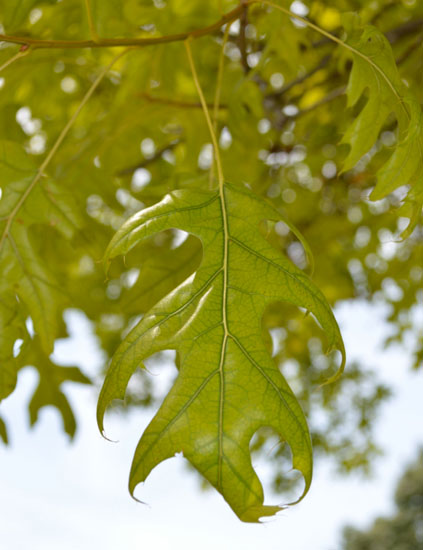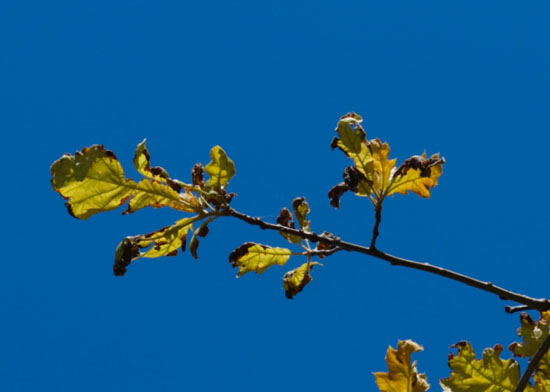Issue 11, July 2, 2012
Iron Chlorosis
Are the leaves on your tree a little more yellow than you remember from previous years? They may be chlorotic, a condition in which leaves turn yellow as a result of destruction of chlorophyll or lack of chlorophyll production. In most cases, chlorosis is the result of a nutrient deficiency caused either by a lack of available nutrients or the inability of the plant to uptake the nutrients.
This year, I have seen many trees with symptoms of Iron Chlorosis. From a distance, the affected trees appear a light green to yellow-green (Image 1), or in severe cases bright yellow (Image 2). Chlorotic foliage is especially pronounced when the trees are grown near unaffected trees. Up-close inspection of the leaves shows yellowing along the leaf margin and between the leaf veins while the leaf veins remain a normal green color (Image 3). Affected leaves may be stunted and/or have browning margins (Image 4). Because iron is a relatively immobile nutrient within plants, we are most likely to see chlorosis on the youngest shoots.

Image 1. Iron Chlorosis on Pin Oak.

Image 2. Severe Iron Chlorosis on River Birch

Image 3. Iron Chlorosis Pin Oak. Note the green leaf veins.

Image 4. Severe Iron Chlorosis with necrotic brown leaf margins
What causes iron chlorosis?
Iron is an essential micronutrient; meaning it is required for plant growth, but it is only used in small amounts. Among its important roles, iron is required for the formation of chlorophyll, the green pigments that capture light to produce food for the plant. When deficient in iron, chlorophyll production is reduced, resulting in chlorosis.
Iron chlorosis can develop under conditions that reduce the availability of iron to the plant, such as those found in high pH soils. A soil pH above 6.5 produces a form of iron unusable to trees. In Illinois, high soil pH is the primary cause for iron chlorosis. Affected trees are commonly found near sidewalks and drive ways constructed with limestone bases.
Cultural and environmental growing conditions can also influence iron deficiency and chlorosis by creating an environment unfavorable for root growth. Compacted soils, poor drainage, root damage and drought all can affect root growth. Last summer’s drought may have contributed to many of the trees currently showing iron chlorosis. Currently, most of the state is abnormally dry or in some degree of drought. Unfortunately, this means we may continue to see iron chlorosis develop.
Options for Treating Iron Chlorosis
- Avoid planting susceptible trees. A soil test can verify whether or not the pH is correct and if adequate nutrients are present.
- Correct poor soil drainage and compaction. Avoid saturating soils with excessive irrigation.
- Fertilize the tree with an available form of iron. The iron may be sprayed onto the foliage, injected into the trunk, or added to the soil. Foliar fertilization provides temporary results and will need to be reapplied as new leaves develop. Trunk injections can last several years but may injure the tree’s trunk. Soil injections get to the root of the problem. The results can last several years. Unfortunately they can be labor intensive and expensive.
- More detailed information on iron chlorosis and control strategies can be found within the links below.
http://web.aces.uiuc.edu/vista/pdf_pubs/ironchl.pdf (Adobe PDF)
city-and-town/tree-care/what-is-iron-chlorosis-and-what-causes-it
preventing-and-treating-iron-chlorosis-in-trees-and-shrubs
(Travis Cleveland)
Author:
Travis Cleveland